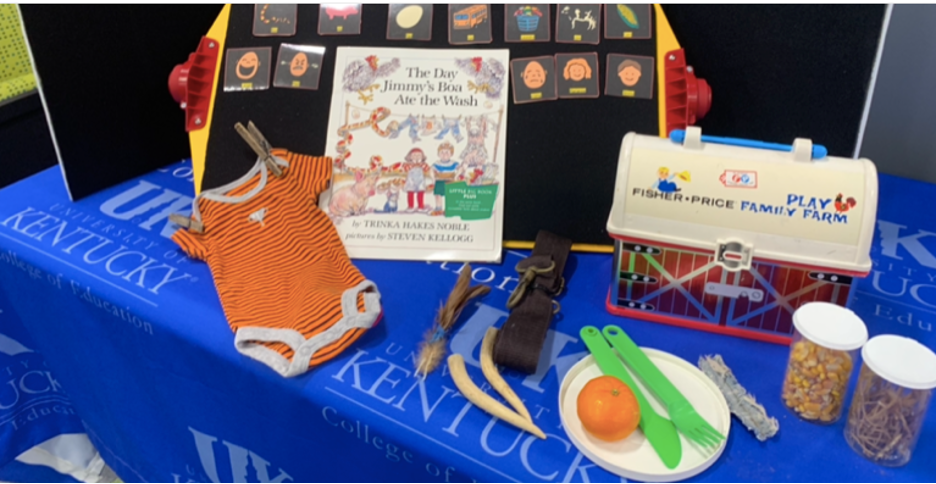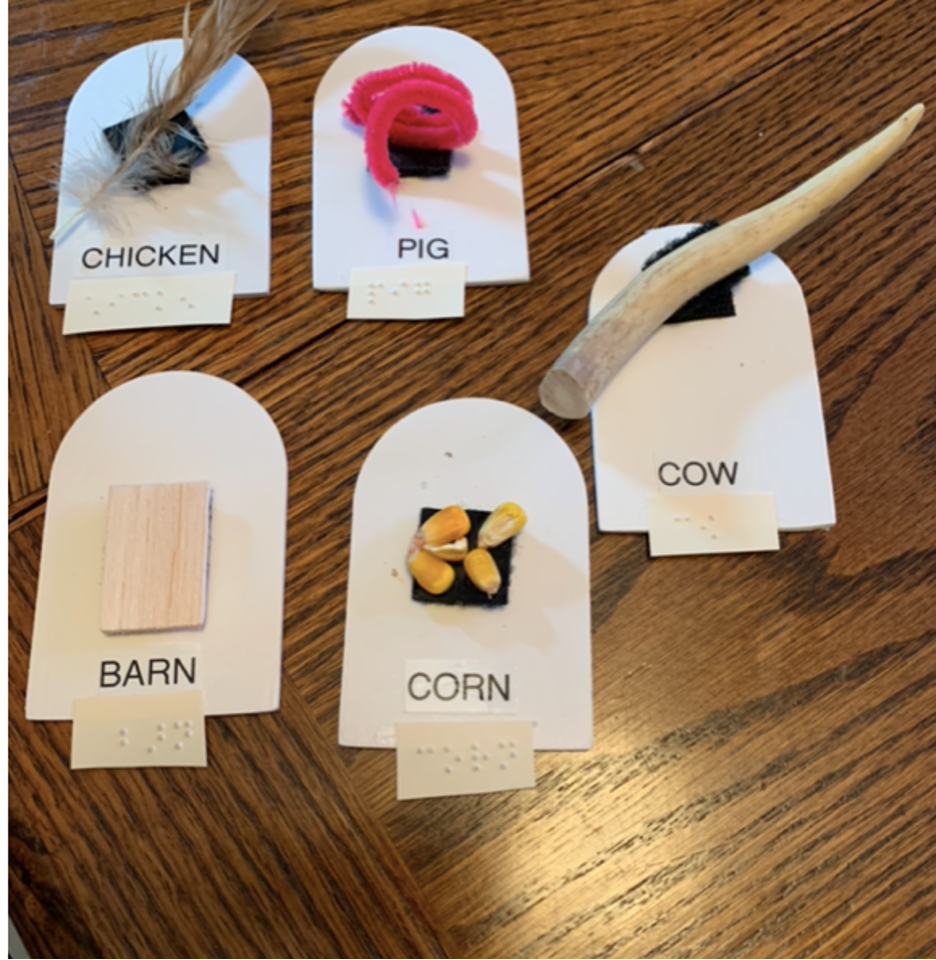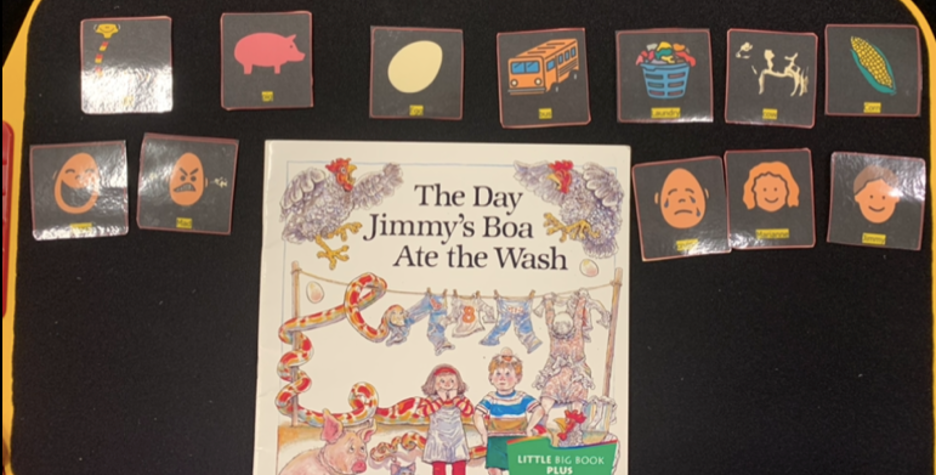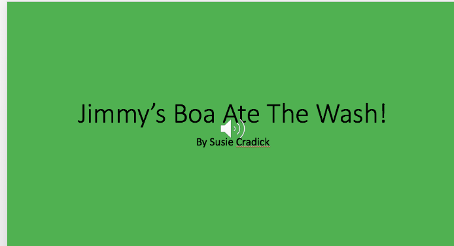Adapting "Jimmy’s Boa Ate the Wash!" for Students with Visual Impairments

As part of the graduate coursework for Visual Impairments and Multiple Disabilities in the Teacher Preparation Program in Visual Impairments at the University of Kentucky, students were asked to complete four projects: a Story Box with at least 10 objects that correspond to the story, picture communication symbols and tactile communication symbols designed to go along with the story, and a talking book to go along with the story or represent concepts from the story.
We are sharing them on Paths to Literacy and hope that others will use them!
I chose Jimmy’s Boa Ate the Wash! by Trinka Noble and illustrated by Steven Kellogg because I work with mostly preschool children. This book keeps the students engaged in the plot and other reading elements. The book is funny and endearing. I would recommend the book to students with visual impairments and multiple disabilities. I would recommend this book to students with multiple disabilities because the book is easy to follow and has easy concepts to understand. The book has a lot of visual clutter, so it makes it hard for students with visual impairments to follow; therefore, it is important to have the tactile symbols to accompany the book to help a student with a visual impairment to better follow the story.
Story Box & Objects
- I chose this book because it was a book with active characters and a sequence of events. I thought this book would hold my student’s attention and be an active book to engage the student. I would recommend the book for a student with visual impairment. It’s a book to bring the story to life and give the student an experience.
- This book worked well because it was an engaging book with lots of exciting characters. The characters interacted with each other and was full of laughter.
- I used a barn lunch box to hold all my objects. This was chosen to help the student visual and feel the story. 1. Plate/fork: to visualize the lunch box that the students brought on the field trip. 2. Clothes pins/clothes: to be an example of the wash that the boa ate. 3. Pig tail: the example of pigs the story. 4. Barn wood: to be able to let students feel and visualize what a barn looks like. 5. Seat Belt: an example of a seat belt on the bus that brought the kids to the farm. 6. Jean material: feels like snake skin. 7. Chicken feathers: the student will be able to feel the feathers and picture what a chicken looks like. 8. Corn: fresh corn to visualize corn cobs during the food fight. 9. Hay: real hay to feel and experience the way hay felt in the story. 10. Cow horns: so a child should experience that some cows have horns.
The story would be used to introduce new vocabulary words and introduce retelling of the story through objects. It would also help the kids with retelling the story by helping to know what happens first, middle, and last.
Tactile Symbols
Materials: The symbols I chose will help a student follow the story.
- Time- blue-when
- Expression- black- why and more
- Person- Yellow- who- you- I
- Expansion- Gray- mad- sad
- Place- Red- Where
- Action- Green- Go- Eat
The symbol cards will be used for the student to have an experience with the story. It will bring the story to life. For example, I chose the following cards:
- Blue card to help retell the story when it took place.
- Black cards-why and more- these would be used to talk about the sequence of events that took place and the card -More symbol to understand one thing lead up to another.
- Yellow- is the who, you, and I- This would introduce the characters in the story.
- Gray card- These cards are mad and sad. It will help get into character of the feelings of the story.
- Red-place- where- This will help the student understand the place/location of the story.
- Green- action- go and eat- This will help show the action of the story and what is happening in the story.
Fringe cards:
- White- real life items- corn- cow horn-wood- barn-feather- chicken- pink curly tail for a pig.
These cards are fringe vocabulary and will help a teacher open up a world of learning. These cards are just a base to start with in my story elements. I could add a great deal more cards. The cards can support retelling the story, teaching sequencing, plot (beginning, middle and end, and building literacy vocabulary.


Picture Symbols
The symbols I used was as follows:
- Egg- This was used for the egg fight in the book.
- Bus- was used to imagine the bus that took the students to the farm.
- Mad- The farmer’s wife was mad that the boa ate the wash.
- Pig- The pigs were on the bus eating the kids' lunches.
- Laundry- The boa ate the wash.
- Cow- The cow was hit by a haystack.
- Corn- The animals had a corn fight.
- Jimmy- character in book
- Laugh- The character laughed a lot in the book.
- Boa- the snake that ate the wash
- Crying- The cow was crying and the kids were crying because the pigs ate their lunches.
- Marianne- main character

Comprehension Questions:
- Could have students retell the story (PLOT): the first, middle, and last.
- Could ask students vocabulary words.
- Could ask questions about farm life.
- Could ask predicting questions.
Talking Book
This is a talking book I created for the story Jimmy's Boa Ate the Wash. I used simple pictures without too much complexity, large print, contrast colors, and recorded each page so that I would give students access to independent learning . The student could use a variety of switches to control the talking book. I will be using this book with low vision students in preschool and a child with multiple disabilities. This is will be a great experience for my students with visual impairments.

